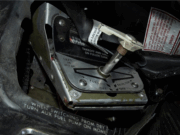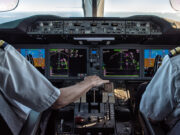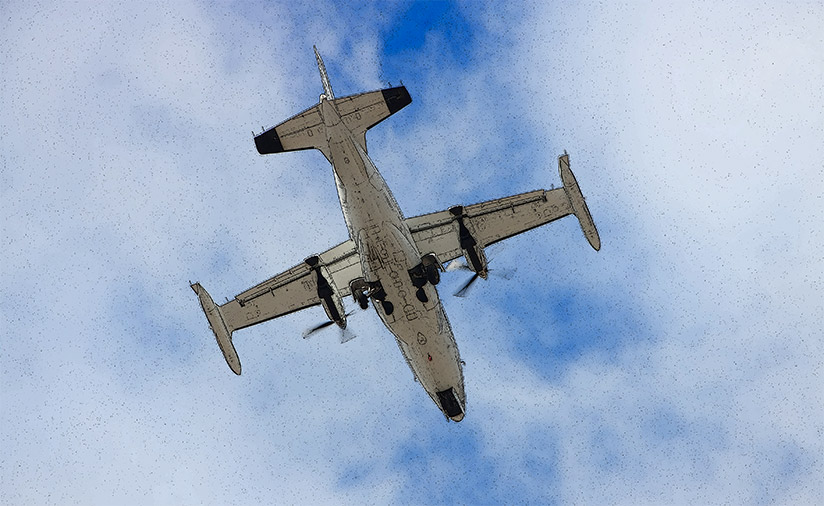
“When the tasks required to fly an aircraft exceed the pilot’s capacity to conduct them, the aircraft starts to ‘get ahead’ of the pilot — or the pilot ‘gets behind’ the aircraft,” said the Transportation Safety Board of Canada (TSB) in explaining a factor that likely was involved in the fatal crash of a Mitsubishi MU-2B-60 Marquise during an approach to Îles-de-la-Madeleine (Quebec) Airport on March 29, 2016.
“In this occurrence,” the TSB’s final report said, “inadequate approach planning and distraction caused by discussions not specific to the flight contributed to the pilot ‘getting behind’ the aircraft, as demonstrated by the following signs: late descent, slow initial rate of descent, minimal corrections to rate of descent and airspeed, failure to complete checklists, and late landing configuration of the aircraft.”
The accident occurred during a private flight with six passengers, including former federal Cabinet minister Jean Lapierre and several members of his family, from Montreal to Îles-de-la-Madeleine.1 The pilot held a Canadian airline pilot license and a U.S. private pilot certificate. He had 2,500 flight hours, including 125 flight hours in the MU-2. “He had flown a variety of single- and multi-engine aircraft,” the report said. “However, the MU-2B was the first high-performance aeroplane that the pilot had flown.”

Because the pilot held a U.S. pilot license, he was subject to the MU-2B training requirements specified by U.S. Special Federal Aviation Regulations (SFAR) 108. The SFAR was adopted in 2009 as a result of a rash of MU-2 accidents. The initial and recurrent training required by the SFAR emphasizes knowledge of the aircraft’s performance characteristics, configuration and airspeed management, awareness of stall and minimum control speed margins, and stall-recovery procedures.
The pilot had completed the initial training requirement in July 2014 and the recurrent training requirement in June 2015. However, the report indicated that his subsequent flying activity in the MU-2 might not have been sufficient to retain proficiency in the aircraft. “During the 20 months that the pilot had flown the occurrence aircraft, he had accumulated about 125 flight hours, of which at least 100 hours were flown under the supervision of a qualified and experienced pilot,” the report said. “In the previous three months, he had logged only about 19 flight hours and, in the previous 30 days, only four flight hours.”
Pilot’s Proficiency Questioned
Noting that “degradation of skills is related to the level of proficiency obtained, the length of time since learning and the repeated use of flight skills following training,” the report said, “It is unlikely that the pilot’s flight skills and procedures were sufficiently practiced to ensure his proficiency as the PIC [pilot-in-command] for single-pilot operation of the MU-2B for the conditions experienced during the occurrence flight.”
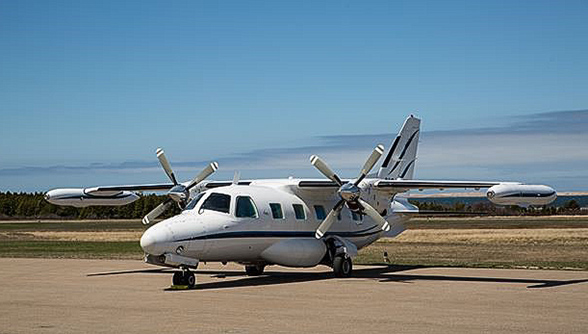 The pilot had logged 100 flight hours under the supervision of qualified pilots to meet insurance requirements for flying the MU-2 as PIC. For most of the subsequent 25 flight hours in the aircraft, the pilot was accompanied by passenger-pilots who held instrument ratings. “These passenger-pilots were not assigned any specific flying duties and were not paid to accompany the pilot; such flights were seen as an opportunity for them to become familiar with the aircraft,” the report said. “Although these passenger-pilots were not type-rated on the MU-2B, they did carry out basic crew-related functions such as following checklists, performing radio communications and operating the GPS [global positioning system equipment].”
The pilot had logged 100 flight hours under the supervision of qualified pilots to meet insurance requirements for flying the MU-2 as PIC. For most of the subsequent 25 flight hours in the aircraft, the pilot was accompanied by passenger-pilots who held instrument ratings. “These passenger-pilots were not assigned any specific flying duties and were not paid to accompany the pilot; such flights were seen as an opportunity for them to become familiar with the aircraft,” the report said. “Although these passenger-pilots were not type-rated on the MU-2B, they did carry out basic crew-related functions such as following checklists, performing radio communications and operating the GPS [global positioning system equipment].”
The passenger-pilot on the accident flight had not previously flown with the pilot or in an MU-2. He held Canadian and U.S. commercial pilot licenses with multi-engine and instrument ratings. He had 834 flight hours, including 111 hours in multiengine aircraft and 85 hours on instruments.
Certified for single-pilot operation, the MU-2B is a high-performance, pressurized twin-turboprop, high-wing aircraft that uses spoilers, rather than ailerons, for roll control. The accident aircraft was manufactured in 1982 and had accumulated 11,758 flight hours. It was registered in the United States.
‘Continual Conversation’
The forecast for the destination called for 1 1/2 mi (2,400 m) visibility in light rain and snow, an overcast ceiling at 300 ft and surface winds from 040 degrees at 30 kt, gusting to 40 kt. These conditions were below the minimums prescribed for both the global navigation satellite system (GNSS) approach and the localizer/distance-measuring equipment (LOC/DME) approach at Îles-de-la-Madeleine. The report noted, however, that Canadian regulations permit pilots of general aviation aircraft to conduct an instrument approach when visibility is at or above 1/4 mi (400 m).
The MU-2 departed from Montreal at about 1030 local time and climbed to Flight Level 210 (approximately 21,000 ft). “During the cruise portion of the flight and until the initial descent was commenced, the pilot and the passenger-pilot engaged in continual conversation,” the report said. “The passenger-pilot was not familiar with the operation of the MU-2B or high-level flight operations in pressurized aircraft. The pilot provided information on the aircraft’s systems and instruments, and explained their operation.”
Before beginning the descent to Îles-de-la-Madeleine, the pilot conducted an approach briefing that included a detailed description of the instrument setup and his intended landing technique. “The pilot indicated he would conduct the approach at 125 kt [and] asked the passenger-pilot to look for the runway and to monitor the airspeed because it was important to maintain the airspeed above 125 kt, the minimum final approach speed specified in the [SFAR] training,” the report said.
The pilot also briefed the passenger-pilot on the GNSS and LOC/DME approaches. Both approaches were to Runway 07, which was 4,493 ft (1,369 m) long. “The pilot stated that he preferred the [GNSS] approach because the autopilot system can remain coupled for the descent and approach,” the report said. The pilot also told the passenger-pilot that if the ceiling was below the minimum descent altitude (MDA) for the GNSS approach — 620 ft, or 598 ft above airport elevation — he could change to the LOC/DME approach and continue to the lower MDA — 480 ft, or 458 ft above airport elevation.
“At no time during the briefing did the pilot indicate under what conditions a go-around would be performed or the procedure to be followed if a missed approach was required,” the report said.
Delayed Descent Increases Workload
After the approach briefing, the pilot programmed the MU-2’s navigation equipment to provide guidance for a 1,500-fpm descent from 21,000 ft to arrive at the initial approach fix at 3,000 ft, the published crossing altitude. He subsequently changed that plan, telling the passenger-pilot that he would delay the descent to save fuel and to minimize the amount of time spent in instrument meteorological conditions.
“The pilot also noted that there would be a 40-knot tailwind on descent,” the report said. “Because they would be closer to [the airport] than originally planned, the pilot indicated that he would have to descend at 250 kt, which is the aircraft’s maximum operating limit speed.” He said the descent rate would be 2,000 fpm.
“This new plan would still have enabled the aircraft to reach [the initial approach fix] at or near 3,000 ft,” the report said. “However, the faster and steeper descent would cause the aircraft to be in a high-energy condition, which would require more vigilant monitoring by the pilot.”
The aircraft was about 64 nm (119 km) from the airport when the pilot began the descent. However, he did not adhere to his revised plan. Rather than the planned descent rate of 2,000 fpm, the descent rate varied from only 800 fpm to 1,800 fpm for several minutes. “This placed the aircraft above the planned descent profile and further compressed the time available to complete subsequent checklist activities, thereby increasing the pilot’s workload.”
About six minutes after initiating the descent, the pilot realized that the aircraft would not reach the initial approach fix at the correct altitude. He reduced power and increased the descent rate to 2,000 fpm. Shortly thereafter, the descent rate increased to 2,400 fpm. “During the descent and approach, the airspeed constantly exceeded the MU-2B’s published values, and the rates of descent exceeded those typically defined by stabilized approach criteria,” the report said.
While completing the descent checklist, the pilot and passenger-pilot engaged in nonessential communication, mostly about operating the aircraft’s systems. After completing the checklist, the pilot briefed the passenger-pilot on how to use the radio to obtain the latest weather report from the airport flight service station (FSS).
After establishing radio communication with the FSS, the passenger-pilot was advised that the surface winds were from 070 degrees at 19 kt, gusting to 24 kt, the visibility was 2 mi (3,200 m) and that there was a broken ceiling at 200 ft and an overcast at 800 ft.
“The broken ceiling at 200 ft was approximately 400 ft lower than the MDA; however, there was no discussion [between the pilots] of the potential risks associated with continuing the approach,” the report said. “No contingency plan, such as performing a go-around if circumstances dictated, was discussed. The pilot continued with his original plan to land.”
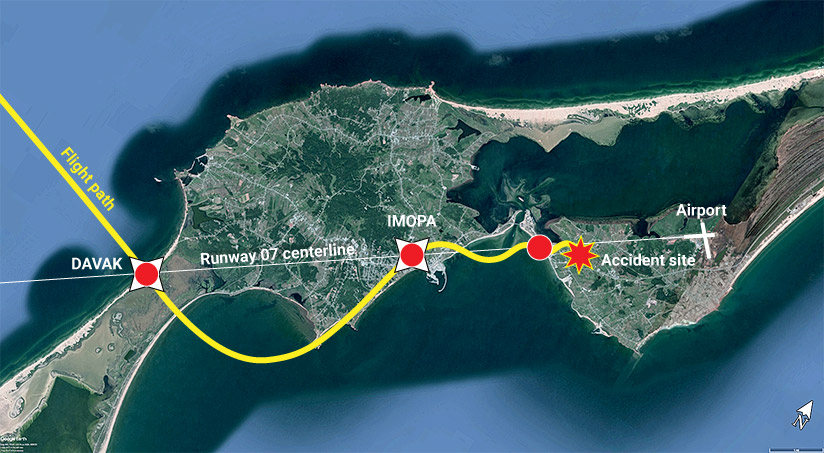
‘Meandering Flight Path’
Indicated airspeed was about 250 kt and the descent rate was 2,400 fpm as the MU-2 descended through 12,000 ft. The pilot reduced power substantially to decrease airspeed and used the landing gear warning horn silence button to prevent the horn from sounding, as designed when power is reduced below a specified value with the landing gear retracted.
Air traffic control approved the pilot’s request to conduct the GNSS approach and told him to contact the FSS. The passenger-pilot again established radio communication with the station and advised that they were 4.7 nm (8.7 km) from the initial approach fix and descending through 6,800 ft. The FSS specialist provided an altimeter setting and advised that the surface winds now were from 060 degrees at 18 kt, gusting to 24 kt, and that the runway was wet.
At 1227, the aircraft crossed the initial approach fix at 4,500 ft — 1,500 ft higher than the published crossing altitude — and at 240 kt — 100 kt above the MU-2B’s recommended approach speed of 140 kt. “This resulted in the aircraft deviating significantly from the inbound course of 072 degrees and subsequently proceeding on a meandering flight path,” the report said. “At this point, the pilot’s workload had increased significantly. There was no time available during the approach to carry out the approach checklist or the before-landing checklist.
“The pilot’s inability to effectively manage the aircraft’s energy condition led to an unstable approach. … Although the pilot realized he was high, fast and not configured for landing, he continued the unstable approach.”
The pilot moved the power levers to idle, causing the gear warning horn to sound. He silenced the horn and told the passenger-pilot that he needed to increase the descent rate because the aircraft was “very high” and that he also needed to slow down to the maximum gear-extension speed.
The power levers remained at idle as the MU-2 crossed the final approach fix 790 ft above the published crossing altitude and at 188 kt — 50 kt too fast. Descent rate was 1,900 fpm. The aircraft was about 3 nm (6 km) from the runway when the pilot extended the landing gear and 5 degrees of flap. By this time, airspeed and descent rate had decreased to 175 kt and 1,200 fpm respectively. “The aircraft continued to descend, and the airspeed continued to slow,” the report said.
“During the final approach, the pilot became primarily focused on individual tasks — based on what he deemed critical at any one time,” the report said. “The pilot’s attention was diverted from monitoring airspeed to monitoring altitude so that the aircraft would not descend below the MDA.”
The MU-2 was descending through 600 ft when the passenger-pilot said that he could see the ground off the right side of the aircraft. “Although the pilot acknowledged this, he did not indicate that he had visual contact with the runway environment,” the report said. “Four seconds later, the pilot stated that he would continue the approach and fly the aircraft manually.”
‘Caught by Surprise’
The pilot talked to the passenger-pilot almost continuously during the approach. However, “at no time during the approach did the pilot discuss discontinuing the approach as an option available to reduce the workload,” the report said.
“During the final moments of the flight, by the time the pilot had refocused his attention on the airspeed, the aircraft had already transitioned to a low-energy condition and the airspeed had decreased to 99 kt, within a few knots of the stall speed of 95 kt,” the report said.
The pilot realized that airspeed was critically low, and he was telling the passenger-pilot about the importance of ensuring that airspeed does not become too slow as he rapidly moved the power levers forward, causing a power-induced upset.
“The aircraft … responded in the manner described in MU-2B documents, which was consistent with the effects of the counterclockwise-rotating propellers,” the report said. “The sudden addition of high power at low airspeed in the MU-2B produces a right-rolling tendency, which can lead to loss of control if not anticipated and corrected.”
The pilot did, indeed, lose control of the aircraft as it abruptly yawed and rolled right, exceeding 70 degrees of bank, and entered a steep descent that reached 4,600 fpm.”
“The pilot was caught by surprise and reacted by trying to counteract these conditions,” the report said. Although he managed to level the wings, the aircraft was too low to allow a complete recovery. The MU-2 struck terrain 1.4 nm (2.6 km) west-southwest of the airport and 1,100 ft (335 m) south of the extended centerline of Runway 07 at 1230. The pilot and his six passengers were killed, and the aircraft was destroyed.
This article is based on Transportation Safety Board of Canada Aviation Investigation Report A16A0032, “Collision With Terrain: Mitsubishi MU-2B-60, N246W; Îles-de-la-Madeleine Airport, Quebec, 1.4 nm WSW; 29 March 2016.”
Note
- Îles-de-la-Madeleine, also called the Magdalen Islands, are about 490 nm (907 km) east-northeast of Montreal in the Gulf of St. Lawrence.
Featured image: © Josh Beasley | Wikimedia Commons CC-BY-SA 2.0
Accident wreckage:Transportation Safety Board of Canada
Accident aircraft: Daniel Villeneuve via Transportation Safety Board of Canada
Flight path: flight information, Transportation Safety Board of Canada, background map, © Google Earth
YouTube video: Transportation Safety Board of Candada
